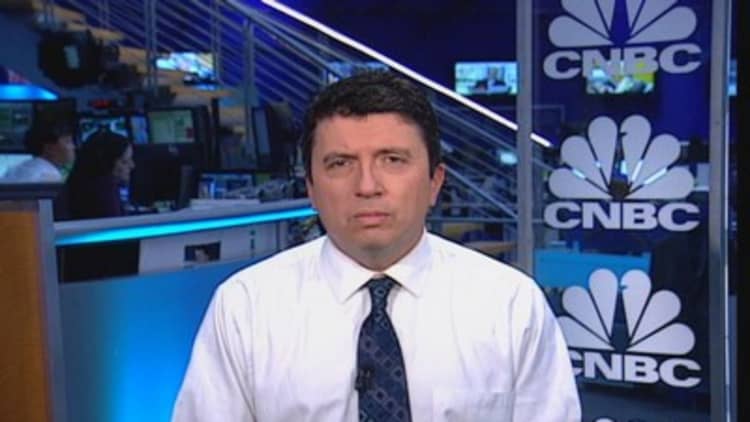The Federal Reserve looks set to move sooner rather than later to taper back its bond buying, once more surprising markets that have been repeatedly confused about when the Fed will begin to step back from its extraordinary easing policy.
Treasury yields ripped higher Wednesday and stocks fell after minutes from the Fed's October meeting revealed that central bank officials felt that they could decide to start scaling back their quantitative easing bond buying at one of its next few meetings, depending on economic growth.
That immediately sent the yield on the 10-year Treasury above 2.79 percent, a level it was last at on Sept. 18, the day the Fed surprised markets by not moving to taper back its $85 billion bond-buying program. Since the strong October jobs report, markets have suspected the Fed could move as early as December though the probability appeared low.
"It probably was underappreciated that December may be in play, especially after some of the recent commentary we've had over the last couple of weeks," said Tom DeMarco, market strategist at Fidelity Capital Markets. "I don't think it is, and I don't think the odds are minuscule for that. If I had to try to put a number on that, I'd say the odds are significant but that's not my base case. ... I'm thinking more January."

The dollar rose and gold was pounded, falling 2.3 percent. The Dow fell 66 to 15,900 and the S&P 500 was off 6 at 1,781.
(Read more: Fickle Fed: Taper could come in coming months)
"I would say on the margin, it brings forward tapering expectations by the market, although we still think December has a relatively low probability of seeing a taper," said Ian Lyngen, senior Treasury strategist at CRT Capital. "They'll have the December employment report but they'll still be in the midst of budget negotiations and a possible debt ceiling debacle in January."
The flow of economic data now becomes even more important, as the markets try to handicap the Fed's next move and whether it sees strong enough employment growth in the Dec. 6 jobs report.
(Read more: Bubble concerns at five-year high)
"I think we're probably going to hang more on some Fed comments going forward, and I think the November jobs report takes on a little more importance as we try to get some clarity," DeMarco said.
There is a heavy dose of economic reports Thursday, including PPI and jobless claims at 8:30 a.m. ET. The Markit manufacturing PMI is released at 8:58 a.m. and leading indicators are at 10 a.m. The Philadelphia Fed survey is also released at 10 a.m.
"Today they got October retail sales and that was a pleasant surprise despite the fact it was during the government shutdown," said Zane Brown, fixed income strategist at Lord Abbett. Retail sales rose 0.4 percent, and showed improvements in automobile purchases but also other areas, like restaurants, furniture and sporting goods.
"It just shows the Fed was accurate in its interpretation there wasn't much impact form the government shutdown, and if it was, it was transitory," he said.
Brown said the Fed is still looking for sufficient evidence to move in December or January, and data like retails sales support the idea that the economy is making progress. "I really didn't think they were going to to do anything until March, but looking at these minutes and the economic data since they last met gives them the ammunition," he said.
Brown also said rates will now be under more pressure. "This is the beginning of a longer-term process that's going to translate to higher yields," he said. "We could get to 3 percent 10 years by March ... people are going to wait to see how aggressive they are."
DeMarco sees a higher range currently. "We're in a 2.60 to 3 percent range on the 10 year through the fourth quarter," he said.
Fed speakers Thursday will now get even more attention, including Fed Gov. Jerome Powell who speaks on over-the-counter derivatives at 9:45 a.m., and St. Louis Fed President James Bullard, who speaks on policy and the economy at 12:50 p.m.
The minutes also showed that Fed officials discussed how to distinguish between their intentions on the asset buying program and their forward interest rate guidance, which they want to emphasize once they start to taper bond buying. Fed Chairman Ben Bernanke, in a speech Wednesday, emphasized the separate paths of the programs and emphasized that the Fed could keep rates near zero well into the future.
"I believe they know what they're doing. They're in control. They're just at a juncture that is moving from where they were to where they're going and struggling a little bit to get there. Look, like you and me, it's not black and white," said Bob Doll, chief equity strategist at Nuveen Asset Management.
"It's gray and they're struggling with 'what do we do, when do we do it and how do we do it,' and that's the danger of this full transparency ... a transparency is great when you're trying to be very clear about something when you're in transition and don't know quite how to do it. It does leave the reader very confused."
Stock traders said while rising rates were a concern, the market was not really that bothered by it. "I would say yes to more volatility with the way Treasurys are acting, but the Vix is flatlining," said one trader. The VIX, the CBOE's volatility index was up 1 cent to 13.40.
But bonds are another story. "the Treasury market is tapering before our eyes," wrote Peter Boockvar, chief market strategist with Lindsey Group, in a note.
Earnings Thursday are expected from Target, Dollar Tree, Autodesk, Gap, Pandora, Abercrombie & Fitch, Ross Stores, Gamestop, Berry Plastics, Splunk and The Buckle.
—By CNBC's Patti Domm. Follow her on Twitter @pattidomm.


